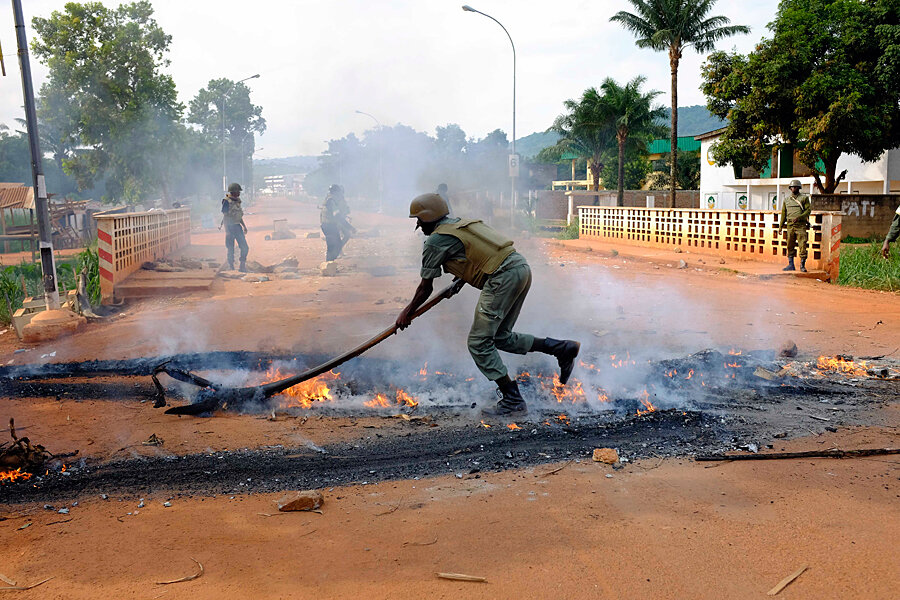Why Central African Republic's year of violence can't be explained as 'religious'
Loading...
A version of this post originally appeared on Foole's No Man's Land. The view expressed are the author's own.
The New York Times "Room for Debate" forum featured a short piece by me as part of their discussion on the possibility of a broader Central African religious war. They had asked for 300 words, but I couldn't quite manage to distill it to that extent. Even at 600 words, I could barely scratch the surface of these complicated issues.
The journalistic interest in religion as a driver of fighting in CAR [the Central African Republic] has been among the reasons I have been reflecting lately about the (im?)possibility of fully accounting for violence as it plays out.
The anthropological stock-in-trade is to make sense of social phenomena that at first appear senseless, and yet I have lately been reflecting on whether there might be limits to that approach when it comes to violence as it happens.
Let me explain:
After the Cold War ended, a number of violent conflicts broke out across the African continent. These included Rwanda, Liberia, Sierra Leone, the Democratic Republic of the Congo: And from the perspective of “The Coming Anarchy”-reading global public, these places all became synonymous with violence at once senseless and barbaric, as well as greedy and self-interested.
A number of anthropologists who had long worked in these locales and knew them differently took up a charge to make sense of the so-called new wars and show their socio-cultural foundations and meaning. Led by Paul Richards, longtime scholar of Sierra Leone, these scholars sought to counter the “new barbarism” thesis that emerged from accounts like Robert Kaplan’s Coming Anarchy.
Excellent ethnographies have resulted from this impetus. To continue just with the case of Sierra Leone, I think of work by Chris Coulter, Mariane Ferme, Danny Hoffman, and Michael Jackson.
There is, however, a time-disconnect between war and ethnography. Ethnography takes time, and it is difficult to do during war.
I know of one intrepid PhD student currently doing ethnographic research in CAR.
During my own research there I stayed far from conflict, even as I tried to understand it, because I was concerned for my own safety. I managed to miss the two major attacks on Ndele that occurred during my time in CAR, in both cases by just days. There tends therefore to be an element of hindsight, or an element of pre-sight (in the case of ethnographic projects interrupted by war), to ethnographic accounts of war and violence. This has struck me repeatedly as I struggle to come to terms with what has been going on in CAR and to explain it for the journalists and others whose queries have been filling my inbox.
I can point to historical and ethnographic dynamics -- A, B, C, D, and E -- that have helped bring people in CAR to their current predicament.
And I can cite grievances -- X, Y, and Z -- that likely motivate the fighters.
But the addition of all those factors does not somehow “add up” to the violence over the past year and a half.
There remains an excess of violence, beyond that which is explainable through reasons -- even reasons related to symbolism and performance.
So while I agree with Richards that the new barbarism ideas are erroneous and damaging, I nevertheless wonder if it might be necessary to step back slightly, or at least step a bit to the side, from the project of making sense of violence.
In listening to interviews with anti-Balaka fighters, I have been struck by the disconnects between why they say they are fighting and what they are actually doing, as well as by the ways they contradict themselves.They claim not to be targeting all Muslims, but only “enemies” from Chad and Sudan who continue to target them. But then they scrawl graffiti declaring “No more mosques in CAR.” And mob violence acts first and asks questions later when it comes to assessing the provenance of “Muslims” who have been identified and targeted.
The danger of referring to the situation in the CAR as motivated by, or playing out through, religious differences is that it hardens and fixes what are actually fluid -- or at least ill-defined -- categories and grievances that have other referents (such as foreignness) as well.
So as violence is ongoing, I wonder if we should be open to the idea that violence might exceed our attempts to make sense of it.
That is not exactly a research agenda, nor does it offer a solution for the journalists tasked with reporting on what is going on. It is, rather, a reminder that when it comes to violence, not everything has a reason.
I think frequently of a comment Ed van der Elsken made in his text accompanying his photo-book Bagara. To preface his description of a particularly chilling hunting expedition that he was part of, he wrote, “The next story is not meant to illustrate the barbarity of hunting, for this was not hunting. Nor was it an incident. Such things happen, I saw them.”.
In other words, the violence unleashed on a heavily-pregnant female elephant was not a scandalous event that set in motion a range of accountability initiatives (legal sanction, self-questioning, the end of the safari, or anything else).
It was just the kind of thing that can happen sometimes when people have empowered themselves with violence, whether through guns or other means.







